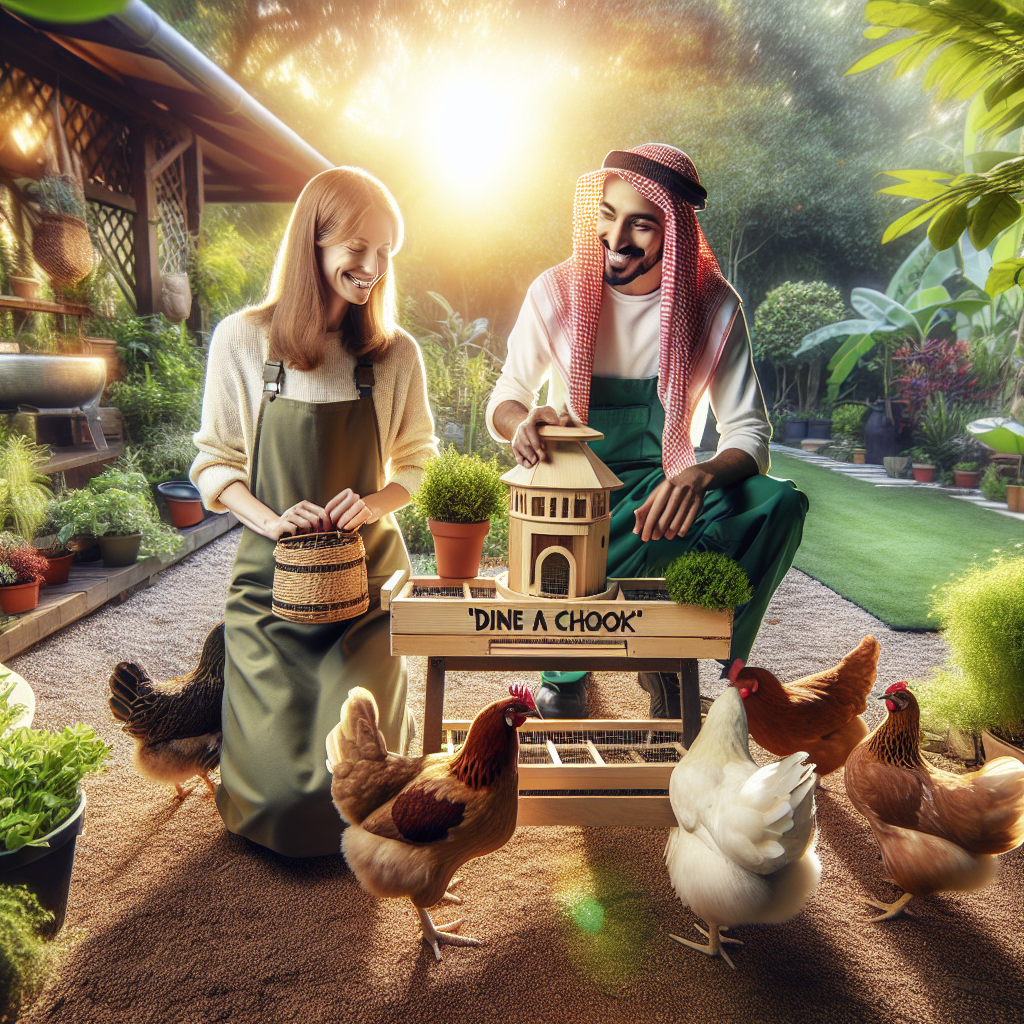Dine A Chook: Revolutionize Your Backyard Chicken Experience
Introduction
Keeping backyard chickens is becoming increasingly popular among eco-conscious consumers and sustainable living enthusiasts. If you’ve recently ventured into raising your own flock, you might have come across the term “dine a chook.” This innovative concept is redefining the way chicken owners manage their feathered friends’ nutrition and overall well-being.
In this comprehensive guide, we’ll explore everything you need to know about dine a chook. From understanding its benefits to practical implementation, we’ve got you covered. By the end of this post, you’ll be well-equipped to ensure your chickens are not only happy but thriving, all while supporting sustainable living practices.
What is Dine a Chook?
Dine a Chook is an advanced feeding system designed to optimize the nutritional intake of backyard chickens. Unlike traditional feeders, this system minimizes waste, discourages pests, and ensures that your chickens are getting the right nutrients at the right time. The concept of dine a chook revolves around providing a balanced diet tailored to the specific needs of your flock.
The beauty of dine a chook lies in its simplicity and efficiency. It’s designed to be user-friendly, making it an excellent choice for both novice and experienced chicken keepers. By adopting this system, you can significantly reduce feed costs and contribute to a more sustainable environment.
For eco-conscious consumers, dine a chook represents a step forward in sustainable living. It aligns with the principles of reducing waste and promoting a more environmentally friendly way of life. In the following sections, we’ll dig deeper into how dine a chook can benefit your chickens and your backyard setup.
Benefits of Dine a Chook Systems
Implementing dine a chook in your backyard can bring numerous benefits. First and foremost, it ensures that your chickens receive a balanced diet, which is crucial for their health and egg production. A well-nourished chicken is a happy chicken, and dine a chook makes that possible in an efficient manner.
Another significant advantage of dine a chook is its ability to minimize feed wastage. Traditional feeders often lead to spillage, attracting pests and rodents. Dine a chook systems are designed to reduce wastage by ensuring that feed is only accessible when the chickens need it. This not only saves money but also keeps your backyard cleaner and safer.
Eco-conscious consumers will appreciate the sustainability aspect of dine a chook. By reducing waste and using eco-friendly materials, these systems contribute to a smaller carbon footprint. Additionally, the longevity of dine a chook products means fewer replacements and less environmental impact over time.
How to Implement Dine a Chook in Your Backyard
Getting started with dine a chook is straightforward and rewarding. The first step is to choose the right feeder for your flock. There are various options available, catering to different flock sizes and setups. Look for feeders that are easy to clean and maintain, as hygiene is paramount to keeping your chickens healthy.
Once you have your dine a chook feeder, installation is the next step. Most feeders come with clear instructions and can be set up within minutes. Position the feeder at a suitable height to ensure that your chickens can easily access it. Regularly check the feeder to make sure it’s functioning correctly and free from blockages.
Integrating dine a chook into your routine involves monitoring your chickens’ feeding habits. Observe how they interact with the feeder and adjust the amount of feed accordingly. By paying attention to their needs, you can fine-tune the system to provide optimal nutrition without overfeeding.
Choosing the Right Feed for Your Flock
Selecting the right feed is crucial when implementing dine a chook. Not all feeds are created equal, and it’s essential to choose one that meets the nutritional requirements of your chickens. A balanced diet should include proteins, vitamins, minerals, and essential fatty acids.
Commercial feeds are generally formulated to provide a complete diet, but you can also supplement with kitchen scraps and garden produce. When using dine a chook, ensure that the feed size is compatible with the feeder design. This prevents clogging and ensures a smooth feeding process.
It’s also worth considering seasonal variations in your chickens’ diet. During the laying season, they may require additional calcium for strong eggshells. Adjusting the feed mix to accommodate these changes ensures that your flock remains healthy and productive year-round.
Maintaining Your Dine a Chook System
Regular maintenance of your dine a chook system is essential to keep it functioning optimally. Start by cleaning the feeder regularly to prevent the buildup of feed residue and bacteria. A simple rinse with warm, soapy water is usually sufficient, but be sure to follow the manufacturer’s guidelines.
Inspect the feeder for any signs of wear and tear. Dine a chook products are built to last, but regular checks can help you spot any potential issues before they become problematic. Replace any damaged parts promptly to maintain the integrity of the system.
Monitoring your chickens’ health is another critical aspect of maintenance. Keep an eye on their behavior and physical condition. Healthy chickens are active, have bright eyes, and produce strong, clean eggs. If you notice any changes, it could be related to their diet or feeder setup, so address any concerns promptly.

The Role of Clean Water in Dine a Chook
Water is just as important as food when it comes to maintaining a healthy flock. Ensure that your chickens have access to clean, fresh water at all times. Consider using a gravity-fed waterer alongside your dine a chook feeder to simplify the process.
Regularly clean the waterer to prevent algae growth and contamination. Chickens can be messy drinkers, so keeping the water supply clean is crucial for their health. Adding a splash of apple cider vinegar to the water can also help maintain their digestive health and keep the water fresh.
Hydration is especially important during hot weather. Chickens are susceptible to heat stress, so providing ample water and shade can help them stay cool. Monitor their water intake and refill as needed to ensure they remain hydrated and healthy.
Dine a Chook and Pest Control
One of the standout features of dine a chook systems is their ability to deter pests. Traditional feeders often attract rodents and other unwanted visitors, which can pose a risk to your chickens and their feed. Dine a chook feeders are designed to minimize spillage, reducing the likelihood of attracting pests.
Positioning the feeder correctly can also help in pest control. Elevate the feeder off the ground and keep the surrounding area clean. This makes it harder for pests to access the feed and discourages them from lingering around your coop.
In addition to using dine a chook, consider implementing other pest control measures. Regularly clean the coop and remove any leftover food or debris. Using natural repellents like peppermint oil can also help keep pests at bay. By combining these strategies, you can create a safer environment for your flock.
Enhancing Egg Production with Dine a Chook
A well-balanced diet is key to maximizing egg production, and dine a chook can play a significant role in achieving this. Providing your chickens with the right nutrients ensures that they have the energy and resources needed for consistent egg-laying.
Calcium is particularly important for laying hens, as it contributes to strong eggshells. Incorporating calcium-rich feed or supplements into your dine a chook system can help boost egg quality. Additionally, ensure that your chickens have access to grit, which aids in digestion and nutrient absorption.
Monitor your flock’s egg production and make adjustments as needed. If you notice a decline in egg output or quality, it may be related to their diet. Consult with a poultry nutritionist to fine-tune your feed mix and ensure your chickens are getting the optimal nutrition for peak egg production.

Community and Support for Dine a Chook Users
Joining a community of like-minded chicken owners can enhance your experience with dine a chook. Online forums, social media groups, and local clubs offer a wealth of knowledge and support. Sharing tips, experiences, and advice with fellow chicken keepers can provide valuable insights and make the learning process more enjoyable.
Many dine a chook users are eager to share their success stories and offer support to newcomers. Engaging with this community can help you troubleshoot any issues and discover new ways to optimize your feeding system. It’s also a great way to stay updated on the latest trends and innovations in backyard chicken keeping.
Participating in community events, such as workshops and meetups, can further enrich your experience. These gatherings provide opportunities to connect with experts, learn new skills, and deepen your understanding of sustainable living practices.
Sustainable Living and Dine a Chook
For eco-conscious consumers, dine a chook aligns perfectly with the principles of sustainable living. By reducing feed waste and promoting efficient resource use, this system supports a more environmentally friendly approach to chicken keeping.
Sourcing feed from local, organic suppliers can further enhance the sustainability of your setup. Supporting local businesses reduces the carbon footprint associated with transportation and ensures that your chickens are consuming high-quality, ethically produced feed.
Additionally, consider incorporating composting into your routine. Chicken manure is a valuable resource for enriching garden soil, and combining it with kitchen scraps and other organic waste can create a nutrient-rich compost. This closed-loop system exemplifies the benefits of sustainable living and contributes to a healthier environment.
Future Innovations in Dine a Chook
The world of backyard chicken keeping is constantly evolving, and dine a chook is at the forefront of innovation. Emerging technologies and new product developments are set to enhance the efficiency and effectiveness of these feeding systems even further.
One exciting area of innovation is the integration of smart technology. Imagine a dine a chook feeder connected to your smartphone, allowing you to monitor feed levels and adjust settings remotely. This level of convenience and control can streamline your routine and ensure your chickens are always well-fed.
Another promising development is the use of eco-friendly materials in feeder construction. Manufacturers are exploring sustainable alternatives to traditional plastics, reducing the environmental impact of their products. These advancements align with the growing demand for eco-conscious solutions in all aspects of life.
Conclusion
Incorporating dine a chook into your backyard chicken-keeping routine can transform the way you care for your flock. From ensuring optimal nutrition and minimizing waste to supporting sustainable living practices, this innovative feeding system offers a myriad of benefits.
By following the tips and insights provided in this guide, you can create a thriving environment for your chickens and enjoy the many rewards of keeping happy, healthy hens. Join the growing community of dine a chook users and experience the difference for yourself.
Ready to take the next step? Explore the range of dine a chook products and start your journey towards a more efficient and sustainable way of chicken keeping today. Your backyard chickens will thank you!














Post Comment